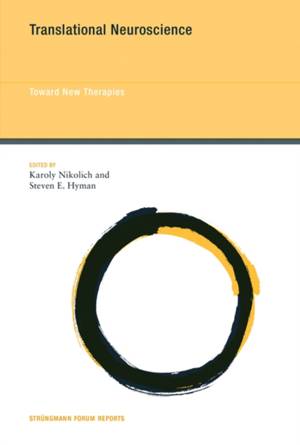
- Retrait gratuit dans votre magasin Club
- 7.000.000 titres dans notre catalogue
- Payer en toute sécurité
- Toujours un magasin près de chez vous
- Retrait gratuit dans votre magasin Club
- 7.000.000 titres dans notre catalogue
- Payer en toute sécurité
- Toujours un magasin près de chez vous
Translational Neuroscience
Toward New Therapies
Description
Today, translational neuroscience faces significant challenges. Available therapies to treat brain and nervous system disorders are extremely limited and dated, and further development has effectively ceased. Disinvestment by the private sector occurred just as promising new technologies in genomics, stem cell biology, and neuroscience emerged to offer new possibilities. In this volume, experts from both academia and industry discuss how novel technologies and reworked translation concepts can create a more effective translational neuroscience.
The contributors consider such topics as using genomics and neuroscience for better diagnostics and biomarker identification; new approaches to disease based on stem cell technology and more careful use of animal models; and greater attention to human biology and what it will take to make new therapies available for clinical use. They conclude with a conceptual roadmap for an effective and credible translational neuroscience--one informed by a disease-focused knowledge base and clinical experience.
Contributors
Tobias M. Böckers, Thomas Bourgeron, Karl Broich, Nils Brose, Bruce N. Cuthbert, Ilka Diester, Gül Dölen, Guoping Feng, Richard Frackowiak, Raquel E. Gur, Stephan Heckers, Franz Hefti, David M. Holtzman, Steven E. Hyman, Nancy Ip, Cynthia Joyce, Tobias Kaiser, Edward H. Koo, Walter J. Koroshetz, Katja S. Kroker, Robert C. Malenka, Isabelle Mansuy, Eliezer, Masliah, Yuan Mei, Andreas Meyer-Lindenberg, Lennart Mucke, Pierluigi Nicotera, Karoly Nikolich, Michael J. Owen, Menelas N. Pangalos, Alvaro Pascual-Leone, Joel S. Perlmutter, Trevor W. Robbins, Lee L. Rubin, Akira Sawa, Mareike Schnaars, Bernd Sommer, Maria Grazia Spillantini, Laura Spinney, Matthew W. State, Marius Wernig
Spécifications
Parties prenantes
- Editeur:
Contenu
- Nombre de pages :
- 320
- Langue:
- Anglais
- Collection :
- Tome:
- n° 17
Caractéristiques
- EAN:
- 9780262029865
- Date de parution :
- 21-08-15
- Format:
- Livre relié
- Format numérique:
- Genaaid
- Dimensions :
- 150 mm x 231 mm
- Poids :
- 748 g






